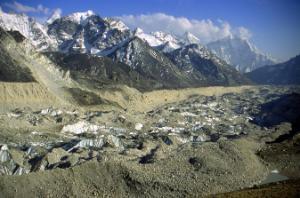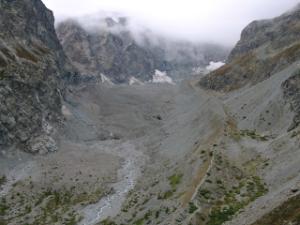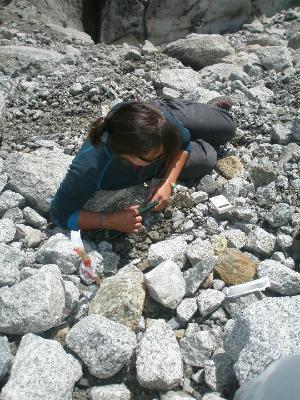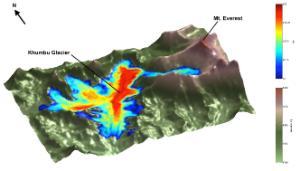Predicting the response of debris-covered glaciers to climate change
CfG staff: , Neil Glasser, Morgan Gibson, Pierre Lardeux
Key collaborators: Duncan Quincey (Leeds), David Egholm (Aarhus, Denmark)
Overview: Mountain glaciers rapidly advance or recede with variations in climate and modify the hydrological budgets of glaciated catchments (e.g. Rowan et al., 2013). In mountainous regions such as the Himalaya (Figure 1), the European Alps (Figure 2) and the Southern Alps of New Zealand the impacts of glacier mass loss on water resources are likely to be severe and the risks to human life posed by glacial hazards will increase with climate change (e.g. Bolch et al., 2012). The Quaternary glacial geological record can be used to make palaeoclimate reconstructions and identify how global climate change controlled glacier extent and dynamics (e.g. Putnam et al., 2013). However, making predictions of the impacts of future climate change on the mountain cryosphere is challenging, particularly for large debris-covered glaciers, as supraglacial debris affects the glacier surface energy balance and ice dynamics (Hambrey et al., 2008).
Mountain glaciers rapidly advance or recede with variations in climate and modify the hydrological budgets of glaciated catchments (e.g. Rowan et al., 2013). In mountainous regions such as the Himalaya (Figure 1), the European Alps (Figure 2) and the Southern Alps of New Zealand the impacts of glacier mass loss on water resources are likely to be severe and the risks to human life posed by glacial hazards will increase with climate change (e.g. Bolch et al., 2012). The Quaternary glacial geological record can be used to make palaeoclimate reconstructions and identify how global climate change controlled glacier extent and dynamics (e.g. Putnam et al., 2013). However, making predictions of the impacts of future climate change on the mountain cryosphere is challenging, particularly for large debris-covered glaciers, as supraglacial debris affects the glacier surface energy balance and ice dynamics (Hambrey et al., 2008).
 We combine 3-D glaciological modelling using the integrated second-order shallow-ice approximation (iSOSIA; Egholm et al., 2011), remote-sensing observations (e.g. Quincey et al., 2011) and the collection of field data (Figure 3) to quantify how debris-covered glaciers respond to Quaternary and 21st Century climate change. We aim to realistically represent the ice dynamics that govern the mass balance and flow of these glaciers in regions where extreme altitude and steep topography mean that accumulation is dominated by avalanching rather than direct snowfall. Our model simulations (Figure 4) and remote-sensing observations will be validated by detailed field observations from Khumbu Glacier in the Nepalese Himalaya and Glacier Noir and Glacier Blanc in the French Alps. Field seasons are planned for Spring and Autumn 2014 to collect field data describing glacier surface geometries and energy balance, supraglacial debris distributions and proglacial hydrological trends.
We combine 3-D glaciological modelling using the integrated second-order shallow-ice approximation (iSOSIA; Egholm et al., 2011), remote-sensing observations (e.g. Quincey et al., 2011) and the collection of field data (Figure 3) to quantify how debris-covered glaciers respond to Quaternary and 21st Century climate change. We aim to realistically represent the ice dynamics that govern the mass balance and flow of these glaciers in regions where extreme altitude and steep topography mean that accumulation is dominated by avalanching rather than direct snowfall. Our model simulations (Figure 4) and remote-sensing observations will be validated by detailed field observations from Khumbu Glacier in the Nepalese Himalaya and Glacier Noir and Glacier Blanc in the French Alps. Field seasons are planned for Spring and Autumn 2014 to collect field data describing glacier surface geometries and energy balance, supraglacial debris distributions and proglacial hydrological trends.
 Key publications and references:
Key publications and references:
Bolch, T., Kulkarni, A., Kääb, A., Huggel, C., Paul, F., Cogley, J.G., Frey, H., Kargel, J.S., Fujita, K., Scheel, M., Bajracharya, S., Stoffel, M., 2012. The State and Fate of Himalayan Glaciers. Science 336, 310–314. Online publication
Egholm, D., Knudsen, M., Clark, C., 2011. Modeling the flow of glaciers in steep terrains: The integrated second-order shallow ice approximation (iSOSIA). Journal of Geophysical Research, 116, F02012. Online publication
Hambrey, M.J., Quincey, D.J., Glasser, N.F., Reynolds, J.M., Richardson, S.J., Clemmens, S., 2008. Sedimentological, geomorphological and dynamic context of debris-mantled glaciers, Mount Everest (Sagarmatha) region, Nepal. Quaternary Science Reviews 27, 2361–2389. Online publication
Putnam, A.E., Schaefer, J.M, Denton, G.H., Barrell, D.J.A., Andersen, B.J., Koffman, T.N.B., Rowan, A.V., Finkel, R.C., Rood, D.H., Schwartz, R., Vandergoes, M, Kelley, S.E., Plummer, M.A., Brocklehurst, S.H., Ladig, K.L. 2013. Warming and glacier recession in the Rakaia valley, Southern Alps of New Zealand during Heinrich Stadial 1. Earth and Planetary Science Letters. 382: 98–110. Online publication
 Quincey, D.J., Braun, M., Glasser, N.F., Bishop, M.P., Hewitt, K., Luckman, A., 2011. Karakoram glacier surge dynamics. Geophysical Research Letters 38, L18504. Online publication
Quincey, D.J., Braun, M., Glasser, N.F., Bishop, M.P., Hewitt, K., Luckman, A., 2011. Karakoram glacier surge dynamics. Geophysical Research Letters 38, L18504. Online publication
Rowan, A.V., Plummer, M.A., Brocklehurst, S.H., Jones, M.A., Schultz, D.M., 2013. Drainage capture and discharge variations driven by glaciation in the Southern Alps, New Zealand. Geology, 41, 199–202. Open Access publication
